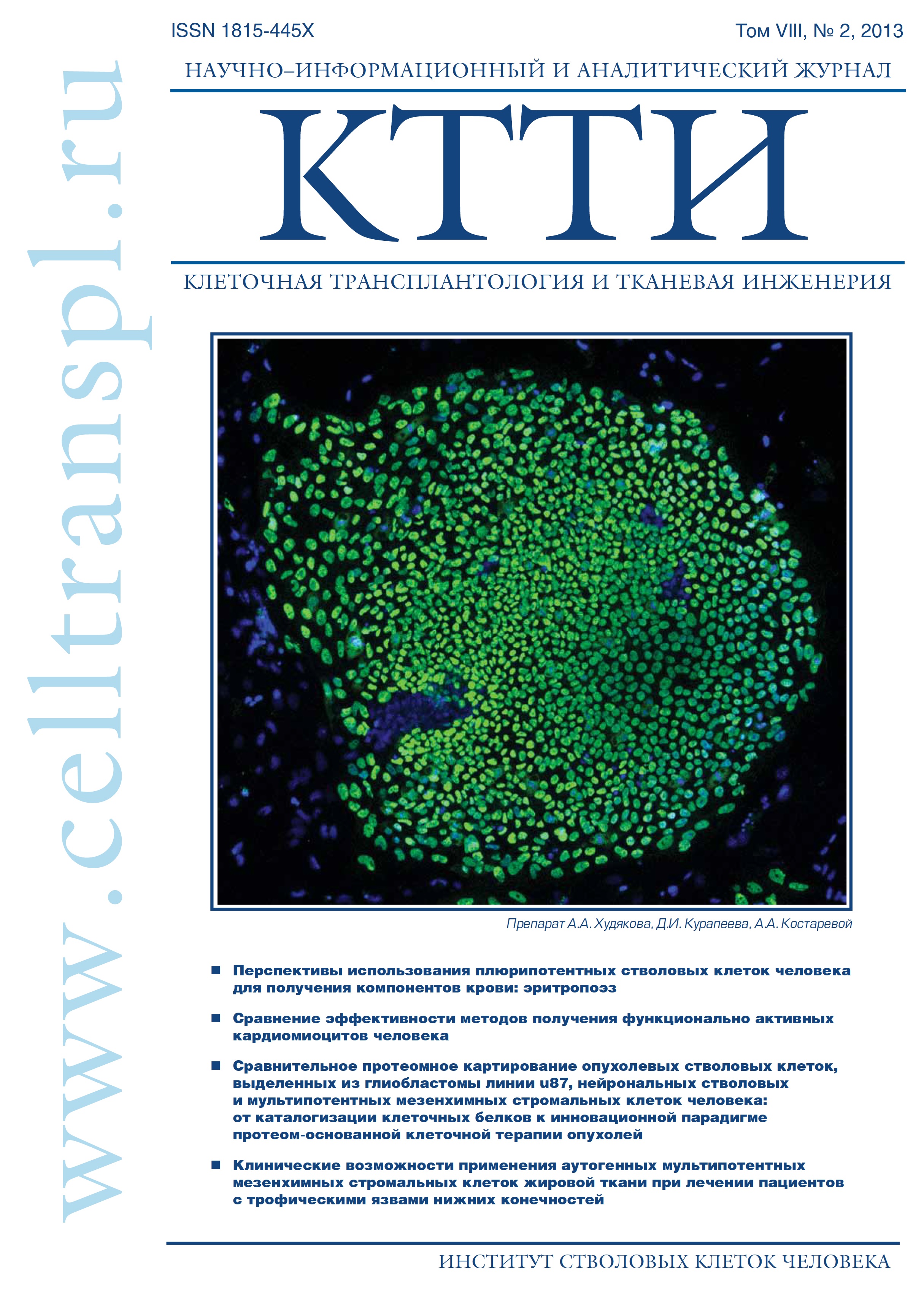Histogenesis of solid-pseudopapillary tumor of a pancreas
- Authors: Paklina O.V1, Gordienko E.N2, Chekmareva I.A2
-
Affiliations:
- A.I. Burnazyan Federal Medical Biophysical Center of FMBA, Russia
- A.V. Vishnevsky Research Institute of Surgery, Moscow
- Issue: Vol 8, No 2 (2013)
- Pages: 64-68
- Section: Articles
- URL: https://genescells.ru/2313-1829/article/view/121611
- DOI: https://doi.org/10.23868/gc121611
- ID: 121611
Cite item
Abstract
Solid-pseudopapillary tumor (SPPO) is a rare tumor of a pancreas with unknown histogenesis. In this regards some theories about its development are discussed including genesis from so called cancer stem cells, which can be derivative of embryonic ovaries primordiums. We studied 11 SPPO and 5 ovarian granulosa cell tumors (GCT) adult type by electron microscopy. A comparative ultrastructural study identified similar features in GCT and SPPO: the presence of two cells types, one of which with characteristic nuclei with deep invaginations nukleolemmy as longitudinal furrows, intercellular contacts in the form of desmosomes, in the tissues quite large number of capillaries in the active state were detected. Among all ovarian tumors developing from cells of sex cord stroma SPPO is the most close to GCT. They are related not only due to morphological similarity, but the biological potential, the clinical course and disease prognosis. Our studies confirm the theory of embryonic migration of ovaries primordiums cells with their subsequent contribution to SPPO histogenesis.
Keywords
Full Text
About the authors
O. V Paklina
A.I. Burnazyan Federal Medical Biophysical Center of FMBA, Russia
E. N Gordienko
A.V. Vishnevsky Research Institute of Surgery, Moscow
I. A Chekmareva
A.V. Vishnevsky Research Institute of Surgery, Moscow
References
- Frantz V.K. Papillary tumors of the pancreas: Benign or malignant? Tumors of the pancreas. In: Atlas of Tumor Pathology, Section 7, Fascicles 27 and 28.Washington, DC, USA: Armed Forces Institute of Pathology, 1959: 32-3.
- Kloppel G., Morohoshi T., John H.D., et al. Solid and cystic acinar tumor of the pancreas. Virchows Arch. A Pathol. Anat. Histol. 1981; 392:171-83.
- Klimstra D.S., Wenig B.M., Heffess C.S. Solid-pseudopapillary tumor of the pancreas: a typically cystic carcinoma of low malignant potential. Semin. Diagn. Pathol. 2000; 17: 66-80.
- Santini D., Poli F., Lega S. Solid-papillary tumors of the pancreas: histopathology. J. Pancreas 2006; 7: 131-6.
- Solcia E., Capella C., Kloppel G. Tumors of the pancreas: Atlas of tumor pathology. USA: Armed Forces Institute of Pathology. 3rd series, Fascicle 20. Washington, DC 1997; 120-130.
- Bosman F.T., Carneiro F. World Health Organization international histological classification of tumors of the Digestive System. 4th Ed. Lion 2010.
- Lieber M.R., Lack E.E., Robert J.R. et al. Solid and papillary epithelial neoplasm of the pancreas. An ultrastuctural and immunohistochemical study of six cases. Am. J. Surg. Pathol. 1987; 11: 185-93.
- Соколова И.Н., Первощиков А.Г., Чистякова О.В. и др. Папиллярные эпителиальные опухоли поджелудочной железы. Архив патологии 1995; 5: 53-7.
- Bergmann F., Andrulis M., Hartwig W. et al. Discovered on gastrointestinal stromal tumor 1 tDOG1) is expressed in pancreatic centroacinar cells and in solid-pseudopapillary neoplasms novel evidence for a histogenetic relationship. Humio Pathol. 2011; 42(6): 817-23.
- Kallichanda N., Tsai S., Stabile B.E. et al. Histogenesis of solid pseudopapillary tumor of the pancreas: the case for the centroacinar cell of origin. Exp. Mol. Pathol. 2006; 81: 101-7.
- Abraham S.C., Klimstra D.S., Wilentz R.E et al. Solid-pseudopapillary tumors of the pancreas are genetically distinct from pancreatic ductal adenocarcinomas and almost always harbor betacatenin mutations. Am. J. Pathol. 2002; 160: 1361-9.
- Boerboom D., Paquet M., Hsieh M., et al. Misregulated Wnt/beta-catenin signaling leads to ovarian granulosa cell tumor development. Cancer Res. 2005; 65(20): 9206-15.
- Stewart C.J., Doherty D., Guppy R. et al. p-Catenin and E-cadherin expression in stage I adult-type granulosa cell tumour of the ovary: correlation with tumour morphology and clinical outcome. Histopathology. 2013; 62(2): 257-66.
- Zamboni G., Scarpa A., Bogina G. et al. Mucinous cystic tumors of the pancreas: clinicopathological features, prognosis, and relationship to other mucinous cystic tumors. Am. J. Surg. Pathol. 1999; 23: 410-22.
- Молдавская А.А., Савищев А.В. Морфогенез и функциональная анатомия поджелудочной железы на этапах онтогенеза. Научные ведомости. Серия Медицина. Фармация 2011. 10 (105) Выпуск 14: 124-7.
- Watanabe D., Miura K., Goto T. et al. Solid Pseudopapillary Tumor of the Pancreas with Concomitant Pancreas Divisum. A Case Report. J. Pancreas 2010; 11(1): 45-8.
- Deshpande V., Oliva E., Young R.H. Solid pseudopapillary neoplasm of the ovary: a report of 3 primary ovarian tumors resembling those of the pancreas. Am. J. Surg. Pathol. 2010; 34: 1514-20.
- Hibi T., Ojima H., Sakamoto Y. et al. A solid pseudopapillary tumor arising from the greater omentum followed by multiple metastases with increasing malignant potential. J. Gastroenterol. 2006;41:276-81.
- Miyazaki Y., Miyajima A., Maeda T. et al. Extrapancreatic solid pseudopapillary tumor: case report and review of the literature. Int. J. Clin. Oncol. 2012; 17(2): 165-8.
- Machado M.C., Machado M.A., Bacchella T. et al. Solid pseudo-papillary neoplasm of the pancreas: distinct patterns of onset, diagnosis, and prognosis for male versus female patients. Surgery 2008; 143: 29-34.
- Tsunoda T., Eto T., Tsurifune T. et al. Solid and cystic tumor of the pancreas in an adult male. Acta Pathol Jpn 1991; 41: 763-70.
Supplementary files










